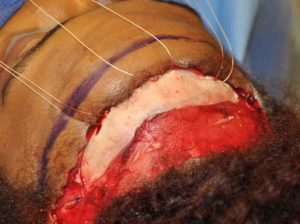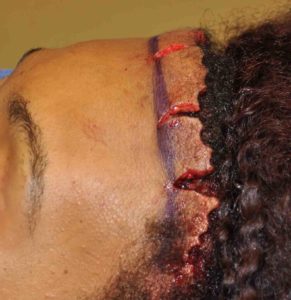The forehead occupies a major portion of one’s face, up to one third of its vertical height. But when the forehead occupies too much real estate of the face, greater than one-third, it can be too overwhelming and look out of proportion to the rest of the face. By definition the vertical length of the forehead is between the frontal hairline and the eyebrows. (in bald or shaved men the amount that the forehead should occupy no longer applies)
The only method to reduce the vertical length of the forehead (forehead reduction) is a hairline advancement. This is essentially a scalp mobilization procedure that changes the location of the front edge of the hair-bearing scalp through forehead skin removal. Its success depends on how much natural elasticity one’s scalp has. Lowering of the hairline with this procedure can usually be done anywhere from 1 to 2.5 cms in most people.
Since such a forehead reduction is a scalp advancement flap, there will be some tension on the incision line. One of the goals of a hairline advancement is to minimize the tension on the skin closure to avoid postoperative scar widening. Such scar widening would be very obvious as a visible white zone at the edge of the frontal hairline.


IDr. Barry Eppley
Indianapolis, Indiana


